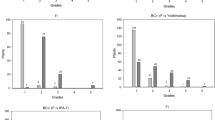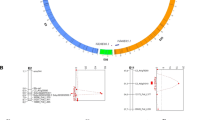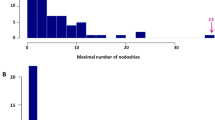Abstract
Resistance to the parthenogenetic root-knot nematodeMeloidogyne incognita is controlled in tomato by the single dominant geneMi, against which virulent pathotypes are able to develop. Isofemale lines (i.e., families) were established from a natural avirulent isolate ofM. incognita in order to study the genetic variability and inheritance of the nematode virulence. From the progeny of individual females, the production of egg masses on the root system of theMi-resistant tomato ‘Piersol’ was analyzed in artificial selection experiments. A family analysis revealed, after two successive generations, a strongly significant variation between the 63 isofemale lines tested, and the results obtained for the mothers and their daughters were also significantly correlated. These results together clearly demonstrate the existence of a genetic variability and inheritance for this character. In a second experiment, a four-generation selection was performed on 31 other isofemale lines. The results revealed a significant response to selection apparently limited only to the two families able to produce, in first generation, a significant minimal egg-mass number on the resistant cultivar.
Similar content being viewed by others
References
Bell AA (1981) Biochemical mechanisms of disease resistance. Annu Rev Plant Physiol 32: 21–81
Bost SC, Triantaphyllou AC (1982) Genetic basis of the epidemiologic effects of resistance toMeloidogyne incognita in the tomato cultivar Small Fry. J Nematol 14: 540–544
Bunting S, Van Emden HF (1980) Rapid response to selection for increased esterase activity on small populations of an apomictic clone ofMyzus persicae. Nature 285: 502–503
Castagnone-Sereno P, Bongiovanni M, Dalmasso A (1993) Stable virulence against the tomato resistanceMi gene in the parthenogenetic root-knot nematodeMeloidogyne incognita. Phytopathology 83: 803–805
Dalmasso A, Bergé JB (1978) Molecular polymorphism and phylogenetic relationship in someMeloidogyne spp.: Application to the taxonomy ofMeloidogyne. J Nematol 10: 323–332
Ellingboe AH (1981) Changing concepts in host-pathogen genetics. Annu Rev Phytopathol 19: 125–143
Fassuliotis G (1979) Plant breeding for root-knot nematode resistance. In: Lamberti F, Taylor CE (eds) Root-knot nematodes (Meloidogyne species). Systematics, biology and control. Academic Press, London New York San Francisco, pp 425–452
Gilbert JC, McGuire DC (1956) Inheritance of resistance to severe root-knot fromMeloidogyne incognita in commercial type tomatoes. Proc Am Soc Hortic Sci 63:437–442
Janssen R, Bakker J, Gommers FJ (1991) Mendelian proof for a gene-for-gene relationship between virulence ofGlobodera rostochiensis and the H1 resistance gene inSolanum tuberosum ssp.andigena CPC 1673. Rev Nematol 14: 213–219
Jarquin-Barberena H, Dalmasso A, De Guiran G, Cardin MC (1991) Acquired virulence in the plant parasitic nematodeMeloidogyne incognita. I. Biological analysis of the phenomenon. Rev Nematol 3:123–134
Keen NT (1990) Gene-for-gene complementarity in plant-pathogen interactions. Annu Rev Genet 24:447–463
Netscher C (1977) Observations and preliminary studies on the occurrence of resistance breaking biotypes ofMeloidogyne spp. on tomato. Cah ORSTOM Ser Biol 11: 173–178
Parsons DA (1980) Isofemale strains and evolutionary strategies in natural populations. In: Hetch M, Steere W, Wallace B (eds) Evolutionary biology, vol 13. Plenum Press, New York, pp 175–217
Prot JC (1984) A naturally occurring resistance breaking biotype ofMeloidogyne arenaria on tomato. Reproduction and pathogenicity on tomato cultivars Roma and Rossol. Rev Nematol 7: 23–28
Riggs RD, Winstead NN (1959) Studies on resistance in tomato to root-knot nematodes and on the occurrence of pathogenic biotypes. Phytopathology 49: 716–724
Roberts PA, Thomason IJ (1986) Variability in reproduction to isolates ofMeloidogyne incognita andM. javanica on resistant tomato genotypes. Plant Dis 70: 547–551
SAS (1985) SAS/STAT Guide for personal computers, version 6. SAS Institute, Cary, N.C.
Sasser JN (1979) Pathogenicity, host range and variability inMeloidogyne species. In: Lamberti F, Taylor CE (eds) Root-knot nematodes (Meloidogyne species). Systematics, biology and control. Academic Press, London New York San Francisco, pp 257–267
Sikora RA, Sitaramaiah K, Singh RS (1973) Reaction of root-knot resistant tomato cultivars toMeloidogyne javanica in India. Plant Dis Rep 57:141–143
Triantaphyllou AC (1971) Genetics and cytology. In: Zuckermann BM, Mai WF, Rohde RA (eds) Plant parasitic nematodes, vol 2. Academic Press, New York, pp 1–32
Triantaphyllou AC (1985) Cytogenetics, cytotaxonomy and phylogeny of root-knot nematodes. In Sasser JN, Carter CC (eds) An advanced treatise onMeloidogyne, vol 1. North Carolina State University Graphics, Raleigh, pp 113–126
Triantaphyllou AC (1987) Genetics of nematode parasitism on plants. In Veech JA, Dickson DW (eds) Vistas on nematology. Society of Nematologists, Hyattsville, pp 354–363
Triantaphyllou AC, Sasser JN (1960) Variation in perineal patterns and host specificity ofMeloidogyne incognita. Phytopathology 50: 724–735
Author information
Authors and Affiliations
Additional information
Communicated by K. Müller
Rights and permissions
About this article
Cite this article
Castagnone-Sereno, P., Wajnberg, E., Bongiovanni, M. et al. Genetic variation inMeloidogyne incognita virulence against the tomatoMi resistance gene: evidence from isofemale line selection studies. Theoret. Appl. Genetics 88, 749–753 (1994). https://doi.org/10.1007/BF01253980
Received:
Accepted:
Issue Date:
DOI: https://doi.org/10.1007/BF01253980




